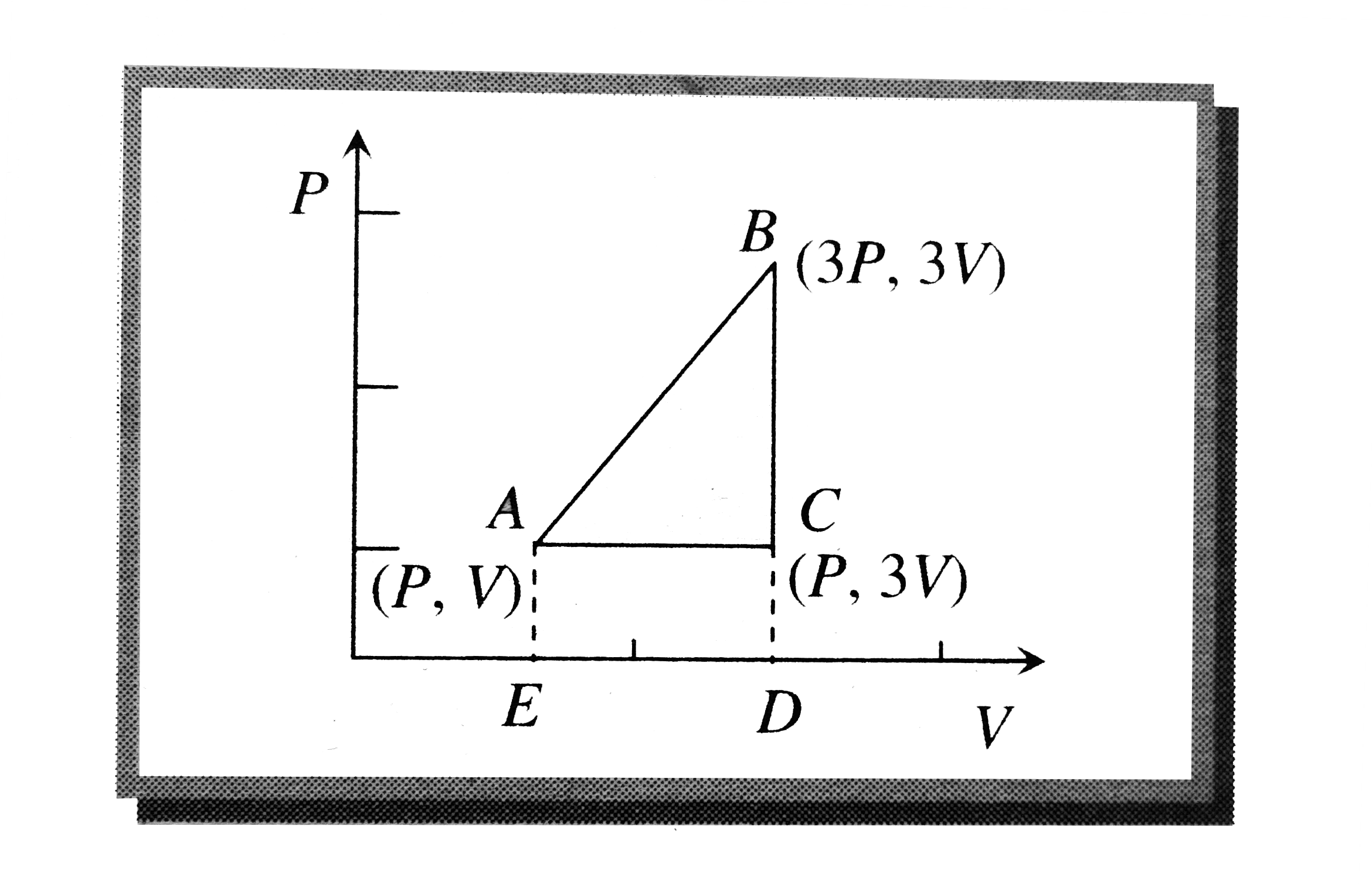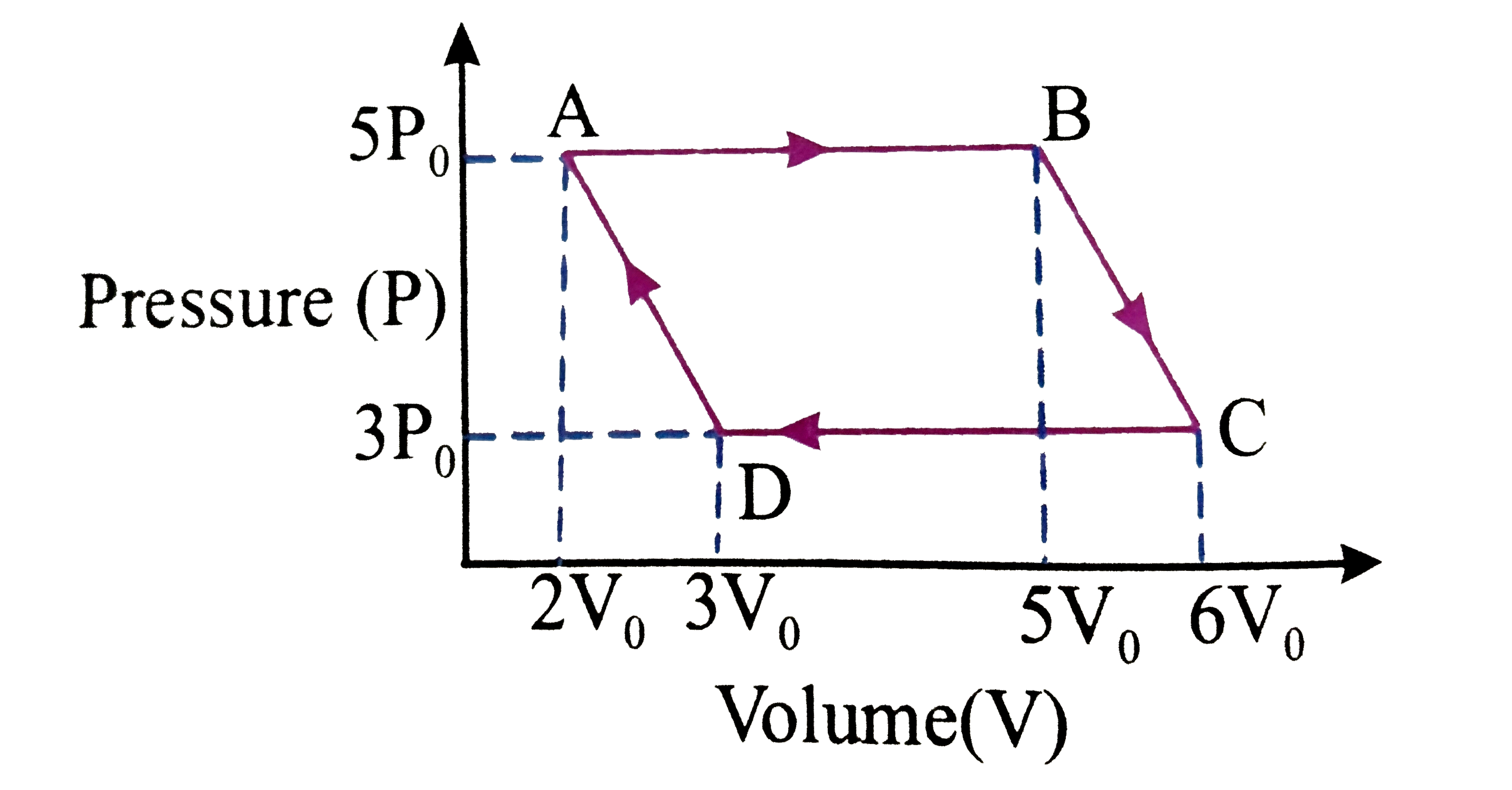Calculate net work done by the gas whose thermodynamical behaviour is represented by right angled triangle ABC on P−V diagram. The P−V diagram co-ordinates are : A(20,6),B(10,12) and C(10,6) where P is in Nm−2 and V is in m3
The correct Answer is:30J
To calculate the net work done by the gas represented by the right-angled triangle ABC on the P-V diagram, we can follow these steps:
Step 1: Identify the coordinates of points A, B, and C.
- A(20, 6)
- B(10, 12)
- C(10, 6)
Step 2: Understand the shape of the triangle.
The triangle ABC is formed by the points A, B, and C in the P-V diagram. The base of the triangle is AC, and the height is BC.
Step 3: Calculate the lengths of the base and height.
- Base (AC): This is the horizontal distance between points A and C.
- AC = Volume at A - Volume at C = 20 - 10 = 10 m³
- Height (BC): This is the vertical distance between points B and C.
- BC = Pressure at B - Pressure at C = 12 - 6 = 6 Nm²
Step 4: Calculate the area of triangle ABC.
The area of a triangle is given by the formula:
Area=12×Base×Height
Substituting the values we calculated:
Area=12×10m3×6Nm−2=12×60=30Joules
Step 5: Conclude the net work done by the gas.
The net work done by the gas during the process represented by the triangle ABC is 30 Joules.
Final Answer:
The net work done by the gas is 30 Joules.
---
- A(20, 6)
- B(10, 12)
- C(10, 6)
The triangle ABC is formed by the points A, B, and C in the P-V diagram. The base of the triangle is AC, and the height is BC.
- Base (AC): This is the horizontal distance between points A and C.
- AC = Volume at A - Volume at C = 20 - 10 = 10 m³
- BC = Pressure at B - Pressure at C = 12 - 6 = 6 Nm²
The area of a triangle is given by the formula:
Area=12×Base×Height
Substituting the values we calculated:
Area=12×10m3×6Nm−2=12×60=30Joules
The net work done by the gas during the process represented by the triangle ABC is 30 Joules.
The net work done by the gas is 30 Joules.
Topper's Solved these Questions
- THERMODYNAMICSBOOK - PRADEEPCHAPTER - THERMODYNAMICSEXERCISE - Multiple choice questions (NCERT)
10 Videos
- THERMODYNAMICSBOOK - PRADEEPCHAPTER - THERMODYNAMICSEXERCISE - Multiple choice questions.
96 Videos
- THERMODYNAMICSBOOK - PRADEEPCHAPTER - THERMODYNAMICSEXERCISE - Multiple choice questions
18 Videos
- SYSTEMS OF PARTICLES AND ROTATIONAL MOTIONBOOK - PRADEEPCHAPTER - SYSTEMS OF PARTICLES AND ROTATIONAL MOTIONEXERCISE - Assertion- Reason Type questions
20 Videos
- WORK, ENERGY AND POWERBOOK - PRADEEPCHAPTER - WORK, ENERGY AND POWEREXERCISE - Assertion-Reason Type Questions
24 Videos
Similar Questions
Knowledge Check
An ideal gas is taken round a cyclic process represened by the triangle ABC drawn in order on a P-V diagram. The coordinates of A, B, C are (4,1), (2,4), (2,1) respectively. The work done in the complete cycle is
A9 unitsB6 unitsC3 unitsD0 unitsIn the cyclic process shown in P-V diagram the magnitude of work done is :
 Aπ(P2−P12)2Bπ(V2−V12)2Cπ4(P2−P1)(V2−V1)Dπ(V2−V1)2
Aπ(P2−P12)2Bπ(V2−V12)2Cπ4(P2−P1)(V2−V1)Dπ(V2−V1)2Anideal gas is taken around ABCA as shown in the above P−V diagram. The work done during a cycle is
 A2PVBPVC1/2PVDZero
A2PVBPVC1/2PVDZero
An ideal monoatomic gas is taken round the cycle ABCDA as shown in the P-V diagram. Compute the work done in the process.

View SolutionThe figure shows P - V diagram of a thermodynamic cycle

The work done in the cycle is
View SolutionWork done in the given P - V diagram in the cyclic process is

View SolutionAn ideal gas undergoes cyclic process ABCDA as shown in givend p−V diagram. The amount of work done by the gas is

View SolutionAn ideal monoatomic gas is taken the cycle ABCDA as shown in following P−V diagram. The work done during the cycle is

View Solution


